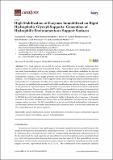Por favor, use este identificador para citar o enlazar a este item:
http://hdl.handle.net/10261/215653COMPARTIR / EXPORTAR:
 SHARE SHARE
 CORE
BASE CORE
BASE
|
|
| Visualizar otros formatos: MARC | Dublin Core | RDF | ORE | MODS | METS | DIDL | DATACITE | |

| Título: | High Stabilization of Enzymes Immobilized on Rigid Hydrophobic Glyoxyl-Supports: Generation of Hydrophilic Environments on Support Surfaces |
Autor: | Orrego, Alejandro H. CSIC ORCID; Romero-Fernández, Maria CSIC ORCID; Millán-Linares, María del Carmen CSIC ORCID ; Pedroche, Justo CSIC ORCID ; Guisán, José Manuel CSIC ORCID ; Rocha-Martín, Javier CSIC ORCID | Palabras clave: | Protein stabilization Protein immobilization 2-picoline borane Methacrylic support Microenvironment Biocatalysis Support hydrophilization |
Fecha de publicación: | 16-jun-2020 | Editor: | Multidisciplinary Digital Publishing Institute | Citación: | Catalysts 10(6): 676 (2020) | Resumen: | Very rigid supports are useful for enzyme immobilization to design continuous flow reactors and/or to work in non-conventional media. Among them, epoxy-methacrylic supports are easily functionalized with glyoxyl groups, which makes them ideal candidates for enzyme stabilization via multipoint covalent immobilization. However, these supports present highly hydrophobic surfaces, which might promote very undesirable effects on enzyme activity and/or stability. The hydrophilization of the support surface after multipoint enzyme immobilization is proposed here as an alternative to reduce these undesirable effects. The remaining aldehyde groups on the support are modified with aminated hydrophilic small molecules (glycine, lysine or aspartic acid) in the presence of 2-picoline borane. The penicillin G acylase from Escherichia coli (PGA) and alcohol dehydrogenase from Thermus thermophilus HB27 (ADH2) were immobilized on glyoxyl-functionalized agarose, Relizyme and Relisorb. Despite the similar density of aldehyde groups displayed by functionalized supports, their stabilization effects on immobilized enzymes were quite different: up to 300-fold lower by hydrophobic supports than by highly hydrophilic glyoxyl-agarose. A dramatic increase in the protein stabilities was shown when a hydrophilization treatment of the hydrophobic support surface was done. The PGA immobilized on the glyoxyl-Relisorb hydrophilized with aspartic acid becomes 280-fold more stable than without any treatment, and it is even more stable than the PGA immobilized on the glyoxyl agarose. | Descripción: | © 2020 by the authors. | Versión del editor: | https://doi.org/10.3390/catal10060676 | URI: | http://hdl.handle.net/10261/215653 | DOI: | 10.3390/catal10060676 | ISSN: | 2073-4344 | E-ISSN: | 2073-4344 |
| Aparece en las colecciones: | (ICP) Artículos (IG) Artículos |
Ficheros en este ítem:
| Fichero | Descripción | Tamaño | Formato | |
|---|---|---|---|---|
| High_Orrego_Art2020.pdf | 825,74 kB | Adobe PDF |  Visualizar/Abrir |
CORE Recommender
SCOPUSTM
Citations
11
checked on 20-abr-2024
WEB OF SCIENCETM
Citations
10
checked on 25-feb-2024
Page view(s)
163
checked on 22-abr-2024
Download(s)
183
checked on 22-abr-2024
Google ScholarTM
Check
Altmetric
Altmetric
Este item está licenciado bajo una Licencia Creative Commons

